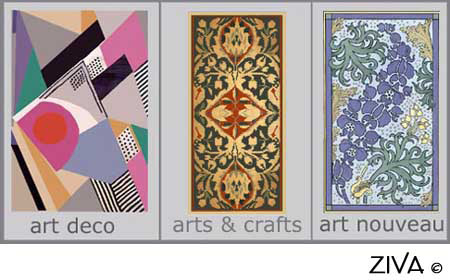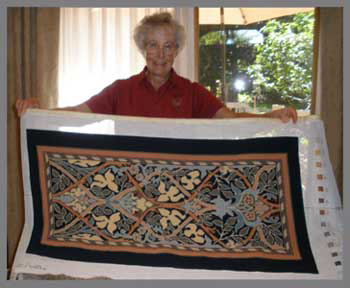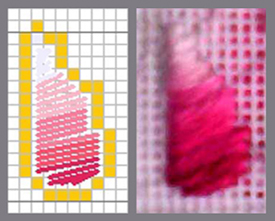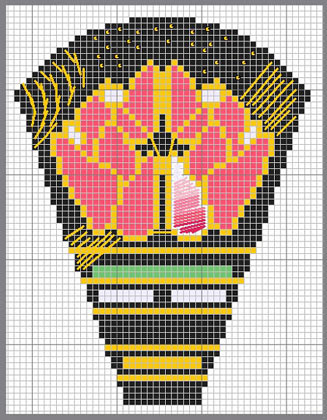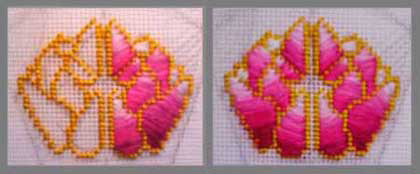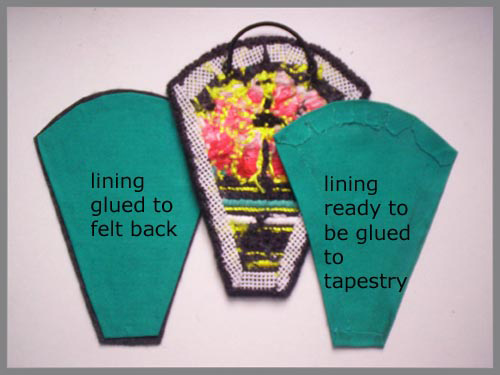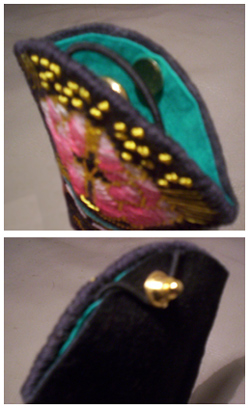| Back to Back Issues Page |
 |
| VIVA ZIVA ! newsletter: Volume # 1212: FREE NEEDLEPOINT SCISSORS CASE DESIGN November 15, 2012 |
|
V I V A Z I V A ! n e w s l e t t e r ▪volume number: 1212 ▪ FREE NEEDLEPOINT SCISSORS CASE DESIGN ▪ Thanks so much for subscribing to the VIVA ZIVA! Newsletter. I’ll be issuing a newsletter regularly, with a new free design each time... exclusively created for this newsletter. This time, I also want to give you a preview of the ZIVA CARPET COLLECTION designs that I’ll be releasing in the coming months!  Learn the Satin Stitch, along with how to do an embroidery stitch called Shading, and stitch this elegant Art Nouveau design, ‘SHADES OF SATIN” , to create an exquisite scissors case.
WHAT’S IN EACH VIVA ZIVA! NEWSLETTER?
NEW DESIGNS & UPDATES ZIVA CARPET COLLECTION DESIGNS 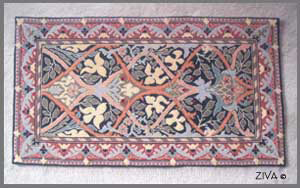
You’ve asked for more needlepoint area rug and carpet designs! They’re coming soon! I’ll be introducing the ZIVA Carpet Collection gradually over the next few months…
I’m creating a lot of styles… there will be one to suit the décor of your home! From Persian designs, to Art Nouveau, Arts and Crafts, Art Deco, Mid-Century Modern, and Contemporary designs…. All coming soon! ZIVA’S DESIGN UPDATES 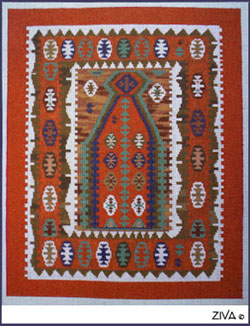
I created a custom shape for the ‘YURUK KILIM’ design specifically for a small rectangular footstool seat at 12.5” x 16”. Since it’s smaller than the original square design you see on the site, I painted it on 14 hpi canvas so the detail wouldn’t be lost (photo of painted canvas on right). Once stitched and upholstered on the footstool, it will be a dynamic addition to my client’s home. I can’t wait to see it! For more detail and background about this intricate design, go to Footstools on the ZIVA Site. 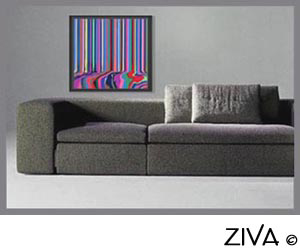
It’s on the ZIVA site as a large cushion,…. Why not! For more detail and background about this dynamic design, go to Cushion Designs on the ZIVA Site.
I’ve saved the best for last! Peg B. from Oregon, USA, just sent me this photo of her superbly finished piano bench canvas of an Arts and Crafts design I painted for her. Her stitching is stunning! Now it’s off to the upholsterer! Congratulations, Peg! For more detail and background about this elegant design, go to Seat Covers on the ZIVA Site. YOUR STITCH TO TRY THE SATIN STITCH 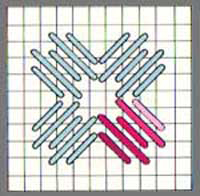
Try the Satin Stitch first as you see it on the chart to the right. This will give you the basic stitch for general use. The Satin Stitch is a traditional embroidery stitch, where the stitches, in different lengths, are sloping over one or several threads. The direction of the stitches varies, depending on the desired effect. For example, it’s used traditionally a great deal in creating leaf-like shapes on a canvas. By experimenting a bit, you can create leaves in varying shapes and sizes to suit your needs.
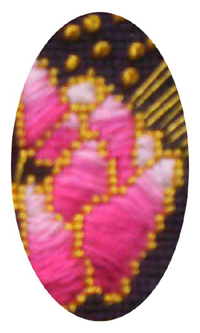 Now you’ve tried the basic Satin Stitch, let’s take it one step further! The photo on the right shows the final effect you’ll want to achieve with the technique of SHADING with the Satin Stitch.
SHADING TECHNIQUE
TIPS I LEARNED I’ve never tried this before, but I soon got the knack! Here are a few tips I learned :
PRACTICE FIRST! Keep practicing until you feel confident that you’ve got it! Then you are ready to stitch the free design. FREE DESIGN ‘SHADES OF SATIN’ SCISSORS CASE DESIGN 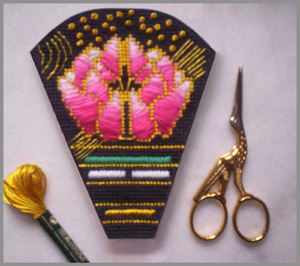
This elegant scissors’ case design, called ‘Shades of Satin’, was inspired by Monet’s Impressionist paintings of water lilies at Giverny. The finished size, 3.5” (at its widest point) x 4.5” long (9 cm x 11.5 cm), is perfect for most embroidery scissors, like the pair shown in photo (1.75” w x 2.5” l). The case will accommodate scissors up to 2.5” wide and 3.5” long. The Satin Stitch , with its shading, allowed me to create a three-dimensional ‘impressionistic’ effect for the water lily petals with a range of colours from deep rose to very light rose and finally white.
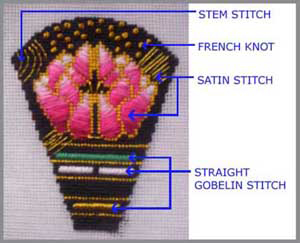
In the photo at right, I have depicted the different stitches you can use to create this scissors’ case. They help create the relevant symbolism to the over-all design.
NOTE: These stitches have already been featured in earlier newsletters: READING THE CHART: NOTE THE FOLLOWING:
YARN COLOURS All colours for the scissors’ case are chosen from DMC yarns They are readily available at your local needlepoint shop or online. DMC SOFT MAT yarns:
PLUS DMC Satin S3820 Gold To stitch the design in the dimensions as shown, you will need 2 skeins of the Charcoal and Satin Gold. You will need 1 skein of the remaining colours. OTHER MATERIALS You will also need :
Go to the ZIVA site for more detail info on the MATERIALS required. STITCHING IN PROGRESS
MAKING UP SUGGESTIONS The following is the method of finishing I decided to go for, mainly to save time. I also think it gives a very neat finish. If you are a proficient sewer, sewing on the lining and backing fabric to make up the scissors case is also an option.
Here’s what I did:(Refer to photo above) This method is quick, very professional looking, and minimum sewing!
ASK THE ZIVA DIVA ! QUESTION: If I order a painted canvas, how long does it for you to hand paint it? Love your designs! Thanks, Barbara, Toledo USA Dear Barbara, Thank you for your kind words about the designs. I understand that when an order is placed, the customer would like to receive it as soon as possible. There are two factors that determine the length of time it takes to paint a canvas for you and when you’ll receive it. PLEASE NOTE: When we receive an order, we immediately tell our client the start-up date. I hope to receive your order soon, Barbara, and I promise you we’ll work diligently to get it to you as soon as we can! Best Regards, Sylvia WHAT NEXT? The next VIVA ZIVA! Newsletter #1313 will be issued in the spring of 2013. I’ll be including: Please contact me if there is a particular stitch you’d like me to use for a free design in a future newsletter! Share this newsletter with friends and relatives. Looking forward to sending you the next newsletter! Sylvia McLeod |
| Back to Back Issues Page |
